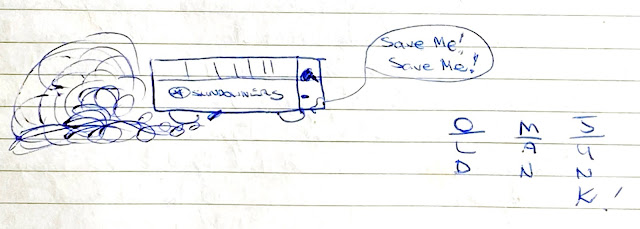 |
| Celsus Library, Ephesus |
Day 87 (London
Day 3) Wed 20 August EPHESUS
– ANZAC COVE
After a night-drive through from Pamukkale we arrived at the top car park at Ephesus at around 2 am and settled down to spend the rest of the night, ready for when the gates opened around 8 am.
COMMENTS: MISTAH! MISTAH! EPHESUS IS CLOSED!
This was a profound Turkish observation made by some local intellectual giant at around 2 am.
How we long for the 3 S’s Shower, shave, shit!
 |
| Street of the Curetes, through Ephesus |
 |
| Roman drainage pipes stacked at Ephesus |
 |
| A place for the Roman males to pontificate at Ephesus |
From Ephesus we will press on to Izmir, ancient Smyrna, and now the third-largest city of Turkey to shop for food, then head on to Çanakkale, stopping off at Troy (Truva). Little now remains of the 9 cities of Troy which date from prior to 3000 BC. Troy would have remained an obscure city on the Dardanelles if it had not been for the poet Homer and his poem ‘The Iliad’ which recounts the 10-year war between the Greeks and the Trojans in 12th century BC.
 |
| The Walls of ancient Troy |
Traditionally the war is said to have been caused by the abduction of the beautiful Helen, wife of Menelaus, King of Sparta, by Paris, son of King Priam of Troy. It had been predicted on his birth that Paris would bring about the destruction of Troy. Priam’s chief herdsman was given instructions to kill the infant Paris on Mt Ida, at the back of Troy, but instead he was abandoned the baby who was suckled by a she-bear. When the herdsman found the infant Paris still alive after a week, he decided to raise the child as his own and it was while attending the cattle that the Olympian Gods decided, as Paris appeared to be honest, to judge a beauty contest between the goddesses Aphrodite, Hera and Athena in what has become known as ‘The Judgement of Paris’. Each of the goddesses offered Paris incentives, but it was Aphrodite who offered Paris the ultimate prize – the most beautiful woman in the world (Helen) as his wife. Paris, a mere mortal, judged Aphrodite the most beautiful, much to the displeasure of the other two goddesses, and, with divine help, Helen was abducted by Paris and fled to Troy, his father’s city. Agamemnon, Menelaus’s brother and King of Mycenae, mobilised his Greek allies and set sail for Troy.
 |
| Group in the ruins of Troy - Wooden Horse at back! |
The resulting war was said to have lasted ten years.
Heroes such as Achilles, Ajax, Odysseus and Patroclus were on the Greek side,
and Hector, Aeneas and Sarpedon on the Trojan side. Hector, son of Priam, was
killed by Achilles who ignominiously dragged Hector’s corpse behind his chariot
around the walls of Troy. Achilles, in turn, was killed by Paris whose arrow
struck him in the heel, where his goddess-mother Thetis held him when she
dunked him in the waters of immortality of the River Styx when he was a child. Sarpedon
was killed by Patroclus who was killed by Hector, hence Achilles’ revenge. Troy
finally fell to the guile of Odysseus who proposed the building of a great
wooden horse – an offering to the Gods who throughout much of the war had taken
sides, but were now neutral. The Greek ships sailed off to hide behind the
nearby island of Tenedos (modern Bozcaada) and the Trojans, believing they had
won, dragged, against the advice of the soothsayer Laocoön (who, with his sons,
was killed by sea serpents sent by Poseidon), the wooden horse into Troy.
Odysseus and a hand-picked group of Greeks were hiding in the horse,
dropped out at night, opened the gates of the city to the Greeks who had
returned under the cover of night and Troy was sacked and Priam and his surviving family were killed. As
punishment by the gods, Odysseus had to suffer a further 10 years of
adventures, related in Homer’s Odyssey before arriving home in Ithaca.
Aeneas, the Trojan, also survived and with a band of followers also sailed the
Mediterranean through a series of adventures (Virgil’s Aeneid) before
settling in Italy and becoming, or so the Romans liked to believe, the ancestor
of the Roman people.
 |
| Wild flowers around the ruins of Troy II |
We
will have dinner at Troy, before proceeding to Çanakkale to catch the ferry
across the Dardanelles to Eceabat on the Gallipoli Peninsula. We will spend the
night in an unfinished Australian War Memorial near Anzac Cove.
Departure time: 6.45am
 |
| Remains of a landing boat still remain on Gaba Tepe in 1981 |
 |
| The Atatürk inscription in Anzac Cove |
The area has been left much the same as it was after the
battles. The Commonwealth War Graves Commission maintain the cemeteries in the
area. The main Australian Memorial is on Lone Pine Ridge and the New Zealand
memorial on the heights of Chunuk Bair. The Turkish commander at Gallipoli was
Mustafa Kemal, later known to the World as Kemal Atatürk.
 |
| Sculpture of Turkish soldier with wounded Australian, near Lone Pine |
From Gallipoli (Gelibolu in Turkish) we press on through Thrace to the city of Edirne, formerly Adrianople, with its great Selimye Mosque, built by Sinan, the famous Ottoman architect, in the 16th century. The border with the Socialist Republic of Bulgaria is not far from Edirne and we will drive on to Sofia, the country’s capital, which we will reach after dark. We will be staying at Camping Vrana.
 |
| The oil-wrestling monument in Edirne, Turkey |
text & photographs ©Neil Rawlins |









